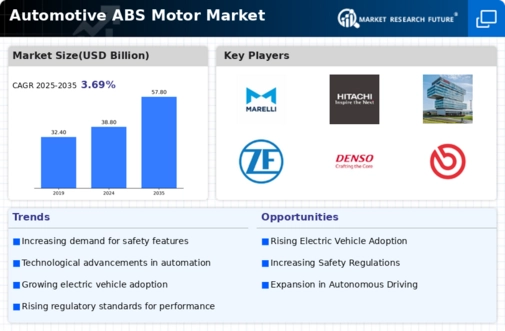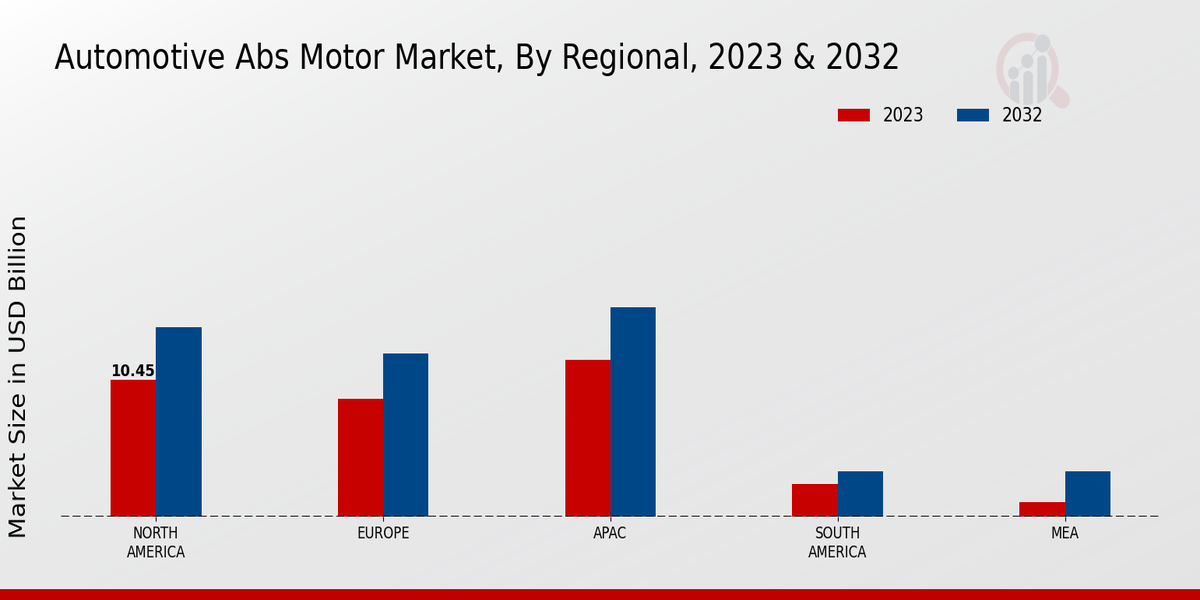Market Growth Projections
The Global Automotive ABS Motor Market Industry is poised for substantial growth, with projections indicating a market value of 38.8 USD Billion in 2024 and an anticipated increase to 57.8 USD Billion by 2035. The compound annual growth rate (CAGR) is estimated at 3.69% from 2025 to 2035, reflecting the industry's resilience and adaptability. Factors such as increasing vehicle production, technological advancements, and regulatory pressures are expected to drive this growth. As the market evolves, stakeholders must remain vigilant to emerging trends and consumer preferences to capitalize on the opportunities presented by this dynamic industry.
Growing Consumer Awareness
Consumer awareness regarding vehicle safety features is on the rise, positively impacting the Global Automotive ABS Motor Market Industry. As individuals become more informed about the benefits of ABS technology, they are increasingly prioritizing safety when purchasing vehicles. This shift in consumer behavior is prompting manufacturers to enhance their offerings, ensuring that ABS motors are a standard feature in new models. The growing demand for safer vehicles is likely to contribute to the market's expansion, with projections indicating a significant increase in market value over the coming years. This trend underscores the importance of consumer preferences in shaping the automotive landscape.
Stringent Safety Regulations
The Global Automotive ABS Motor Market Industry is significantly influenced by stringent safety regulations imposed by governments worldwide. Regulatory bodies are increasingly mandating the inclusion of ABS in new vehicles to reduce accident rates and enhance road safety. This regulatory push is expected to drive the adoption of ABS motors, as manufacturers strive to comply with these standards. As a result, the market is projected to grow at a CAGR of 3.69% from 2025 to 2035. The emphasis on safety not only benefits consumers but also encourages manufacturers to innovate and improve their ABS technologies.
Increasing Vehicle Production
The Global Automotive ABS Motor Market Industry is experiencing growth due to the rising production of vehicles worldwide. As manufacturers ramp up output to meet consumer demand, the need for advanced safety features, including Anti-lock Braking Systems (ABS), becomes paramount. In 2024, the market is projected to reach 38.8 USD Billion, reflecting the industry's commitment to enhancing vehicle safety. This trend is likely to continue as automakers prioritize the integration of ABS motors in their designs, ensuring compliance with stringent safety regulations. Consequently, the demand for ABS motors is expected to rise, driving market expansion.
Expansion of Electric and Hybrid Vehicles
The rise of electric and hybrid vehicles is reshaping the Global Automotive ABS Motor Market Industry. As these vehicles gain popularity, the demand for advanced braking systems, including ABS, is expected to increase. Electric and hybrid vehicles often require specialized ABS motors to accommodate their unique performance characteristics. This trend is likely to drive innovation in ABS technology, as manufacturers seek to optimize braking performance for these new vehicle types. The market's growth is further supported by the anticipated increase in overall vehicle production, contributing to a robust demand for ABS motors in the coming years.
Technological Advancements in ABS Systems
Technological innovations play a crucial role in the Global Automotive ABS Motor Market Industry. The integration of advanced sensors and electronic control units in ABS systems enhances vehicle safety and performance. These developments not only improve braking efficiency but also contribute to overall vehicle stability. As manufacturers invest in research and development, the market is likely to witness the introduction of more sophisticated ABS motors. This trend aligns with the projected growth of the market, which is expected to reach 57.8 USD Billion by 2035. Such advancements are pivotal in meeting consumer expectations for safety and performance.











